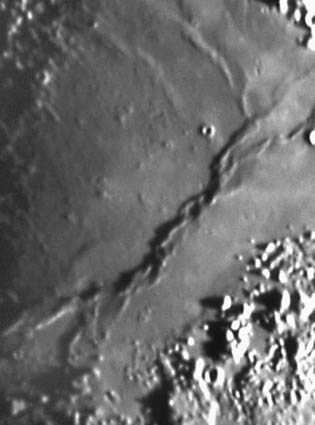Difference between revisions of "February 8, 2005"
| Line 12: | Line 12: | ||
</table> | </table> | ||
<table width="80%" border="0" align="center" cellpadding="8"> | <table width="80%" border="0" align="center" cellpadding="8"> | ||
| − | <tr><td><div align="center" class="main_sm">Image Credit: [mailto:kcpaulhk@yahoo.com.hk K.C. Pau]</p> | + | <tr><td><div align="center" class="main_sm"><p>Image Credit: [mailto:kcpaulhk@yahoo.com.hk K.C. Pau]</p> |
</div></td> | </div></td> | ||
</tr> | </tr> | ||
| Line 21: | Line 21: | ||
<p align="left">East of Copernicus there is a cluster of 200-250 km wide roughly circular mare patches (Vaporum, Medii, and Aestuum) that presumably occupy degraded basins or craters. [[August_21,_2004|Mare Vaporum]] has the strongest hints of circular structure, but the east side of Sinus Aestuum (Bay of Billows, whatever that means) includes an arcuate series of mare ridges that is also suggestive of a possible inner ring. The area inside the braided mare ridge seems lower than the area outside it; perhaps the ridge traces a fault and the inner part of the Sinus has subsided. The area inside is also rougher, with many apparent small hills. But if you look at a higher res (but lower Sun) [http://www.lpi.usra.edu/resources/lunar_orbiter/bin/info.shtml?305 Lunar Orbiter IV] view, you'll see that the "hills" are really small craters. Many of these craters are Copernicus secondaries, which are younger than any of the Aestuum lavas, but the impression is that the lava within the mare ridges might be older than that in the surrounding moat. Getting back to the braided ridge - it contains at least two circular depressions that may simply be accidents of lighting and shallow topography, but suggest collapse pits, which are rare on mare ridges.</p> | <p align="left">East of Copernicus there is a cluster of 200-250 km wide roughly circular mare patches (Vaporum, Medii, and Aestuum) that presumably occupy degraded basins or craters. [[August_21,_2004|Mare Vaporum]] has the strongest hints of circular structure, but the east side of Sinus Aestuum (Bay of Billows, whatever that means) includes an arcuate series of mare ridges that is also suggestive of a possible inner ring. The area inside the braided mare ridge seems lower than the area outside it; perhaps the ridge traces a fault and the inner part of the Sinus has subsided. The area inside is also rougher, with many apparent small hills. But if you look at a higher res (but lower Sun) [http://www.lpi.usra.edu/resources/lunar_orbiter/bin/info.shtml?305 Lunar Orbiter IV] view, you'll see that the "hills" are really small craters. Many of these craters are Copernicus secondaries, which are younger than any of the Aestuum lavas, but the impression is that the lava within the mare ridges might be older than that in the surrounding moat. Getting back to the braided ridge - it contains at least two circular depressions that may simply be accidents of lighting and shallow topography, but suggest collapse pits, which are rare on mare ridges.</p> | ||
<blockquote> | <blockquote> | ||
| − | <p align="right">— [mailto:tychocrater@yahoo.com Chuck Wood]</blockquote> | + | <p align="right">— [mailto:tychocrater@yahoo.com Chuck Wood]</p></blockquote> |
<p align="left"><b>Technical Details:</b><br> | <p align="left"><b>Technical Details:</b><br> | ||
Nov 20,2004. 250 mm f/6 Newtonian + 5X Barlow + Phillips Toucam Pro; 23 stacked frames.</p> | Nov 20,2004. 250 mm f/6 Newtonian + 5X Barlow + Phillips Toucam Pro; 23 stacked frames.</p> | ||
<p><b>Related Links:</b><br> | <p><b>Related Links:</b><br> | ||
Rukl Sheet 32 | Rukl Sheet 32 | ||
| + | </p> | ||
<p align="left"><b>Tomorrow's LPOD: </b> Lunar Postcard</p> | <p align="left"><b>Tomorrow's LPOD: </b> Lunar Postcard</p> | ||
</tr> | </tr> | ||
Revision as of 21:15, 17 January 2015
What's Happening at Aestuum?
Image Credit: K.C. Pau |
|
What's Happening at Aestuum? East of Copernicus there is a cluster of 200-250 km wide roughly circular mare patches (Vaporum, Medii, and Aestuum) that presumably occupy degraded basins or craters. Mare Vaporum has the strongest hints of circular structure, but the east side of Sinus Aestuum (Bay of Billows, whatever that means) includes an arcuate series of mare ridges that is also suggestive of a possible inner ring. The area inside the braided mare ridge seems lower than the area outside it; perhaps the ridge traces a fault and the inner part of the Sinus has subsided. The area inside is also rougher, with many apparent small hills. But if you look at a higher res (but lower Sun) Lunar Orbiter IV view, you'll see that the "hills" are really small craters. Many of these craters are Copernicus secondaries, which are younger than any of the Aestuum lavas, but the impression is that the lava within the mare ridges might be older than that in the surrounding moat. Getting back to the braided ridge - it contains at least two circular depressions that may simply be accidents of lighting and shallow topography, but suggest collapse pits, which are rare on mare ridges. Technical Details: Related Links: Tomorrow's LPOD: Lunar Postcard |
|
Author & Editor: Technical Consultant: Contact Translator: A service of: |
COMMENTS?
Register, and click on the Discussion tab at the top of the page.




